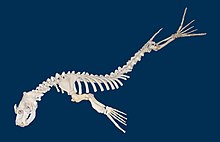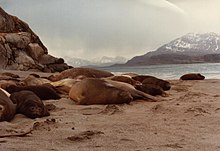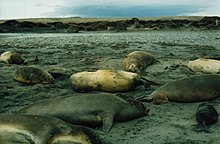Szablon:Pp-move-indef Szablon:Taxobox
Słoń morski południowy (Mirounga leonina) – jeden z dwóch żyjących obecnie gatunków słonia morskiego.
Budowa[edytuj | edytuj kod]


Słoń morski południowy różni się od północnego (których zasięgi występowania się nie zazębiają) większą masą ciała i krótszą trąbą. Samce z południa wydają się też wyższe w czasie walki, wyginając swe ciała silniej, niż w przypadku gatunku północnego. Występuje silnie wyrażony dymorfizm płciowy w wielkości, być może najwyraźniejszy wśród zwierząt. Samce są 5-6 razy cięższe od samic[1]. Samice typowo ważą 400-800 kg, mierząc od 2,6 do 3 m długości. Samce ważą zaś 2200-4000 kg i mierzą 4,2-5,8 m[2][3]. Średnia masa dorosłej samicy wynosi 771 kg, a samca – 3175 kg[4][5]. Wykazano, że słonie morskie z South Georgia są średnio o około 30% cięższe i 10% dłuższe od tych z Macquarie Island[1]. Rekordowej wielkości byk ustrzelony w Possession Bay (South Georgia and the South Sandwich Islands) 28 lutego 1913 mierzył 6,85 m długości, a jego masę oszacowano na 5000 kg[6][7]. Maksymalne rozmiary samicy to 3,7 m i 1000 kg[8].
Zwierzę ma duże, okrągłe, czarne oczy. Ich długość i wysokie stężenie pigmentów związanych z widzeniem skotopowym sugeruje istotną rolę wzroku w łapaniu zdobyczy. Jak wszystkie fokowate, słonie morskie dysponują tylnymi kończynami, których końce współtworzą ogon i płetwę ogonową. Każda ze stóp obejmuj 5 długich, złączonych błoną pławną palców.The eyes are large, round, and black. The width of the eyes, and a high concentration of low-light pigments, suggest sight plays an important role in the capture of prey. Like all seals, elephant seals have hind limbs whose ends form the tail and tail fin. Each of the "feet" can deploy five long, webbed fingers. This agile dual palm is used to propel water. The pectoral fins are used little while swimming. While their hind limbs are unfit for locomotion on land, elephant seals use their fins as support to propel their bodies. They are able to propel themselves quickly (as fast as 8 km/h (Błąd: Zła jednostka docelowa. Zobacz konwertowane jednostki.)) in this way for short-distance travel, to return to water, to catch up with a female, or to chase an intruder.
Pups are born with fur and are completely black. Their coats are unsuited to water, but protect infants by insulating them from the cold air. The first moulting accompanies weaning. After moulting, the coats may turn grey and brown, depending on the thickness and moisture of hair. Among older males, the skin takes the form of a thick leather which is often scarred.
Like other seals, the vascular system of elephant seals is adapted to the cold; a mixture of small veins surround arteries, capturing heat from them. This structure is present in extremities such as the hind legs.
Range and population[edytuj | edytuj kod]
The world population was estimated at 650,000 animals in the mid-1990s,[9] and was estimated in 2005 at between 664,000 and 740,000 animals.[10] Studies have shown the existence of three geographic subpopulations, one in each of the three oceans.
Tracking studies have indicated the routes traveled by elephant seals, demonstrating their main feeding area is at the edge of the Antarctic continent. While elephant seals may come ashore in Antarctica occasionally to rest or to mate, they gather to breed in subantarctic locations.

The largest subpopulation is in the South Atlantic, with more than 400,000 individuals, including about 113,000 breeding females on South Georgia;[11] the other breeding colonies are located on the Falkland Islands and Valdes Peninsula in Argentina (the only continental breeding population).
The second subpopulation, in the south Indian Ocean, consist of up to 200,000 individuals, three-quarters of which breed in the Kerguelen Islands and the rest in the Crozet Islands, Marion and Prince Edward Islands, and Heard Island. Some individuals also breed on Amsterdam Island.

The third subpopulation of about 75,000 seals is found in the subantarctic islands of the Pacific Ocean south of Tasmania and New Zealand, mainly Macquarie Island.
Colonies once existed in Tasmania, Saint Helena, and the Juan Fernández Islands off the coast of Chile. Some individuals at the time of moulting have been found in South Africa or Australia. Lost animals have also been reported from time to time on the shores of Mauritius, with two reports from the Río Guayas estuary area in Ecuador.[10]
After the end of large-scale seal hunting in the 19th century, the southern elephant seal recovered to a sizable population in the 1950s; since then, an unexplained decline in the subpopulations of the Indian Ocean and Pacific Ocean has occurred. The population now seems to be stable; the reasons for the fluctuation are unknown. Suggested explanations include a phenomenon of depression following a rapid demographic rebound that depletes vital resources, a change in climate, competition with other species whose numbers also varied, or even an adverse influence of scientific monitoring techniques.Szablon:Cytuj pismo needed
Lifestyle[edytuj | edytuj kod]
Social behavior and reproduction

Elephant seals are among the seals that can stay on land for the longest periods of time, as they can stay dry for several consecutive weeks each year. Males arrive in the colonies earlier than the females and fight for control of harems when they arrive.[12] Large body size confers advantages in fighting and the agonistic relationships of the bulls gives rise to a dominance hierarchy with access to harems and activity within harems, being determined by rank.[13] The dominant bulls (“harem masters”) establish harems of several dozen females. The least successful males have no harems, but may try to copulate with a harem male's females when the male is not looking. The majority of primiparous females and a significant proportion of multiparous females mate at sea with roaming males away from harems.[14]

An elephant seal must stay in his territory to defend it, which could mean months without eating, having to live on his blubber storage. Two fighting males use their weight and canine teeth against each other. The outcome is rarely fatal, and the defeated bull will flee; however, bulls can suffer severe tears and cuts. Some males can stay ashore for more than three months without food. Males commonly vocalize with a coughing roar that serves in both individual recognition and size assessment.[13] Conflicts between high-ranking males are more often resolved with posturing and vocalizing than with physical contact.[13]
Generally, pups are born rather quickly in the breeding season.[15] After being born, a newborn will bark or yap and its mothers will respond with a high-pitched moan.[16] The newborn begins to suckle immediately. Lactation lasts an average of 23 days. Throughout this period, the female fasts. Newborns weigh about 40 kg (88,18 lb) at birth, and reach 120 to (Błąd: Zła jednostka konwertowana. Zobacz konwertowane jednostki.) by the time they are weaned. The mother loses significant weight during this time. Young weaned seals gather in nurseries until they lose their birth coats. They enter the water to practice swimming, generally starting their apprenticeship in estuaries or ponds. In summer, the elephant seals come ashore to moult. This sometimes happens directly after reproduction.
Feeding and diving

Satellite tracking revealed the seals spend very little time on the surface, usually a few minutes for breathing. They dive repeatedly, each time for more than 20 minutes, to hunt their prey —squid and fish— at depths of 400 to (Błąd: Zła jednostka konwertowana. Zobacz konwertowane jednostki.). They are the deepest diving air-breathing non-cetaceans and have been recorded at a maximum of 2133 m (6998,03 ft) in depth.[17]

As far as duration, depth, and the sequence of dives, the southern elephant seal is the best performing seal. In many regards, they exceed even most cetaceans. These capabilities result from nonstandard physiological adaptations, common to marine mammals, but particularly developed in elephant seals. The coping strategy is based on increased oxygen storage and reduced oxygen consumption.
In the ocean, the seals apparently live alone. Most females dive in pelagic zones for foraging, while males dive in both pelagic and benthic zones.[18] Individuals will return annually to the same hunting areas. Due to the inaccessibility of their deep-water foraging areas, no comprehensive information has been obtained about their dietary preferences, although some observation of hunting behavior and prey selection has occurred.[19]
While hunting in the dark depths, elephant seals seem to locate their prey, at least in part, using vision; the bioluminescence of some prey animals can facilitate their capture. Elephant seals do not have a developed system of echolocation in the manner of cetaceans, but their vibrissae (facial whiskers), which are sensitive to vibrations, are assumed to play a role in search of food. When at the subantarctic or Antarctic coasts, the seals can also consume molluscs, crustaceans, nothothens,[20] lanternfish,[20] krill, cephalopods[21].
Conservation[edytuj | edytuj kod]

After their near extinction due to hunting in the 19th century, the total population was estimated at between 664,000 and 740,000 animals in 2005,[10] but as of 2002, two of the three major populations were declining.[22] The reasons for this are unclear, but are thought to be related to the distribution and declining levels of the seals' primary food sources.[22] Most of their most important breeding sites are now protected by international treaty, as UNESCO World Heritage Sites, or by national legislation.
Minazo[edytuj | edytuj kod]
One of the most famous southern elephant seals is Minazo, which lived in Japan's Enoshima Aquarium from when he was a half-year old until his death in 2005.[23] Minazo became popular for his signature bucket-holding, tongue-lolling pose. In 2006, Minazo was memorialized by the Japanese noise musician Masami Akita, also known as Merzbow, in a two-volume album,[24][25] with artwork by Jenny Akita showing Minazo holding his beloved bucket.
In 2007, Minazo became the subject of an image macro similar to lolcat called "lolrus". In his liner notes, Masami Akita suggested Minazo's frequent and demanding performances left him exhausted, contributing ultimately to his death.Szablon:Cytuj pismo needed Akita's intention in celebrating Minazo was to highlight the plight of captive animals used for performance before public audiences.[23] Minazo has also featured on several t-shirt designs.
Przypisy[edytuj | edytuj kod]
- ↑ a b William F. Perrin, Bernd Würsig & J. G. M. Thewissen: Earless Seals. Wyd. 2. Burlington, Massachusetts: Academic Press, 24-11-02008, s. 346. ISBN 978-0-12-373553-9.
- ↑ Southern Elephant Seal.
- ↑ D. Block, Philip Meyer, P. Myers: Miroun. 2004.
- ↑ Amita Sarkar: Social Behaviour In Animals. New Delhi: Discovery Publishing House, 2003. ISBN 978-81-7141-747-6.
- ↑ Maurice Burton & Robert Burton: Elephant Seal. Tarrytown, NY: Marshall Cavendish Corporation, 15-01-2013, s. 772. ISBN 978-0-76-1472667.
- ↑ Wood, The Guinness Book of Animal Facts and Feats. Sterling Pub Co Inc (1983), ISBN 978-0-85112-235-9
- ↑ Mark Carwardine: Animal Records. New York: Sterling, 2008, s. 61. ISBN 978-1-4027-5623-8.
- ↑ Wood, Gerald: The Guinness Book of Animal Facts and Feats. 1983. ISBN 978-0-85112-235-9.
- ↑ Błąd w przypisach: Błąd w składni elementu
<ref>. Brak tekstu w przypisie o nazwieiucn - ↑ a b c Juan José Alava, Raúl Carvajal. First records of elephant seals on the Guayaquil Gulf, Ecuador: on the occurrence of either a Mirounga leonina or M. angustirostris. „Latin American Journal of Aquatic Mammals”. 4 (2), July/December 2005. Rio de Janeiro: Sociedade Latino-Americana de Especialistas em Mamíferos Aquáticos. ISSN 1676-7497.
- ↑ I. L. Boyd, T. R. Walker, J. Poncet. Status of Southern Elephant seals at South Georgia. „Antarctic Science”. 8 (3), 1996. DOI: 10.1017/S0954102096000338. ISSN 0954-1020.
- ↑ E. Jones. Age in relation to breeding status of the male Southern Elephant Seal, Mirounga leonina (L.), at Macquarie Island. „Australian Wildlife Research”. 8 (2), 1981. DOI: 10.1071/WR9810327.
- ↑ a b c T. S. McCann. Aggression and sexual activity of male Southern elephant seals, Mirounga leonina. „Journal of Zoology”. 195 (3), 1981. DOI: 10.1111/j.1469-7998.1981.tb03467.x.
- ↑ P.J.N. de Bruyn, C.A. Tosh, M.N. Bester, E.Z. Cameron i inni. Sex at sea: alternative mating system in an extremely polygynous mammal. „Animal Behaviour”. 82, 2011. DOI: 10.1016/j.anbehav.2011.06.006.
- ↑ T. S. McCann. Population structure and social organization of Southern Elephant Seals, Mirounga leonina (L.). „Biological Journal of the Linnean Society”. 14 (1), 1980. DOI: 10.1111/j.1095-8312.1980.tb00102.x.
- ↑ Link, J. K.; Bryden. M. M. (1992). "Mirounga leonina". Mammalian Species 391:1–8.
- ↑ McIntyre, T., de Bruyn, P.J.N., Ansorge, I.J., Bester, M.N., Bornemann, H., Plötz, J. and Tosh, C.A., 2010a. A lifetime at depth: vertical distribution of southern elephant seals in the water column. Polar Biology 33, 1037-1048
- ↑ M. A. Hindell, D. J. Slip & H. R. Burton. The diving behavior of adult male and female Southern Elephant Seals, Mirounga leonina (Pinnipedia, Phocidae). „Australian Journal of Zoology”. 39 (5), 1991. DOI: 10.1071/ZO9910595.
- ↑ 2002. Elephant Seal. Columbia Encyclopedia, Vol. 1, sixth Edition. New York: Columbia University Press.
- ↑ a b G. Daneri & A. Carlini. Fish prey of southern elephant seals, Mirounga leonina, at King George Island. „Polar Biology”. 25 (10), 2002. DOI: 10.1007/s00300-002-0408-5.
- ↑ P. G. Rodhouse, T. R. Arnbom, M. A. Fedak, J. Yeatman & A. W. A. Murray. Cephalopod prey of the southern elephant seal, Mirounga leonina L.. „Canadian Journal of Zoology”. 70 (5), 1992. DOI: 10.1139/z92-143.
- ↑ a b Perrin, Wursig, and Thewissen, p. 371.
- ↑ a b Popular Enoshima aquarium seal dies after 10Szablon:Frac-year run. , 7 October 2005.
- ↑ Szablon:Allmusic
- ↑ Szablon:Allmusic
Bibliography[edytuj | edytuj kod]
- Biology, threats and conservation status of the SUB-ANTARCTIC FUR SEAL AND SOUTHERN ELEPHANT SEAL in Australian waters. 2004.
- D. Block, Philip Meyer, P. Myers: Mirounga leonina (Southern elephant seal). 2004.
- Mirounga leonina, [w:] Integrated Taxonomic Information System [online] (ang.).
- Mirounga leonina, Southern Elephant Seal.
- Perrin, W.F.; Wursig, Bernd G.; and Thewissen, J.G.M. Encyclopedia of Marine Mammals. San Diego, Calif.: Academic Press, 2002.
- Southern Elephant Seals.
- Southern elephant seals biology.
External links[edytuj | edytuj kod]
- Szablon:Commons-inline
- ARKive – images and movies of the southern elephant seal
- Southern Elephant Seal
- Elephant Seal Research Group